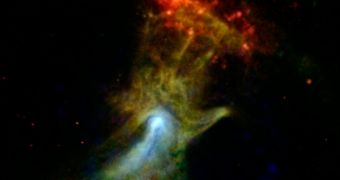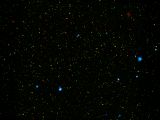Astronomers have recently released a new image of the Hand of God, the remnant of a dying massive star that shines brightly in the night sky. This amazing image was collected by the NASA Nuclear Spectroscopic Telescope Array (NuSTAR), the world's first zoomable X-rays space telescope.
The same observatory was used in a related study to identify a number of supermassive black holes in the distant Universe, which release vast volumes of radiations at these wavelengths, and therefore appear as bright dots in NuSTAR's field of view. The observatory is especially sensitive to the highest-energy X-rays, scientists say.
NASA engineers say that this instrument was developed to operate at frequencies more energetic than those observable with the American space agency's Chandra X-ray Observatory (CXO), or the European Space Agency's (ESA) XMM-Newton observatory.
Due to the fact that NuSTAR can zoom, it can detect objects both near and far with equal precision and detail. This was made amply obvious by the two new images, which center on objects located billions of light-years away from each other.
“NuSTAR's unique viewpoint, in seeing the highest-energy X-rays, is showing us well-studied objects and regions in a whole new light,” explains the principal investigator of the mission, expert Fiona Harrison. She holds an appointment at the California Institute of Technology, in Pasadena, California.
The Hand of God nebula, termed thusly due to its resemblance to a giant hand, is located just 17,000 light-years away from Earth, which practically puts it in our backyards. The structure is produced by the death throes of a star called PSR B1509-58 (B1509), astronomers say.
As its designation implies, B1509 is a pulsar, a type of neutron star that spins around its axis at extremely high speeds, while releasing radiations from its poles. In some cases, these objects are oriented with respect to Earth in a manner that makes astrophysicists see them as lighthouses.
The 19-kilometer (12-mile) pulsar may be very small, but it contains millions of times the mass of Earth. Scientists estimate that a single teaspoon of matter from such an object would weigh more than 100 trillion tons, heavier than the Himalayas.
“We don't know if the hand shape is an optical illusion. With NuSTAR, the hand looks more like a fist, which is giving us some clues,” says McGill University expert Hongjun An. In other wavelengths, the nebula looks a lot more like a hand than in NuSTAR data.
The distant population of black hole astronomers centered on next was studied because experts want to gain new knowledge into how these mysterious objects appeared and developed, and also why this happened.
“This is a hot topic in astronomy. We want to understand how black holes grew in the past and the degree to which they are obscured,” explains Yale University researcher and NuSTAR science team member, Francesca Civano.

 14 DAY TRIAL //
14 DAY TRIAL // 
